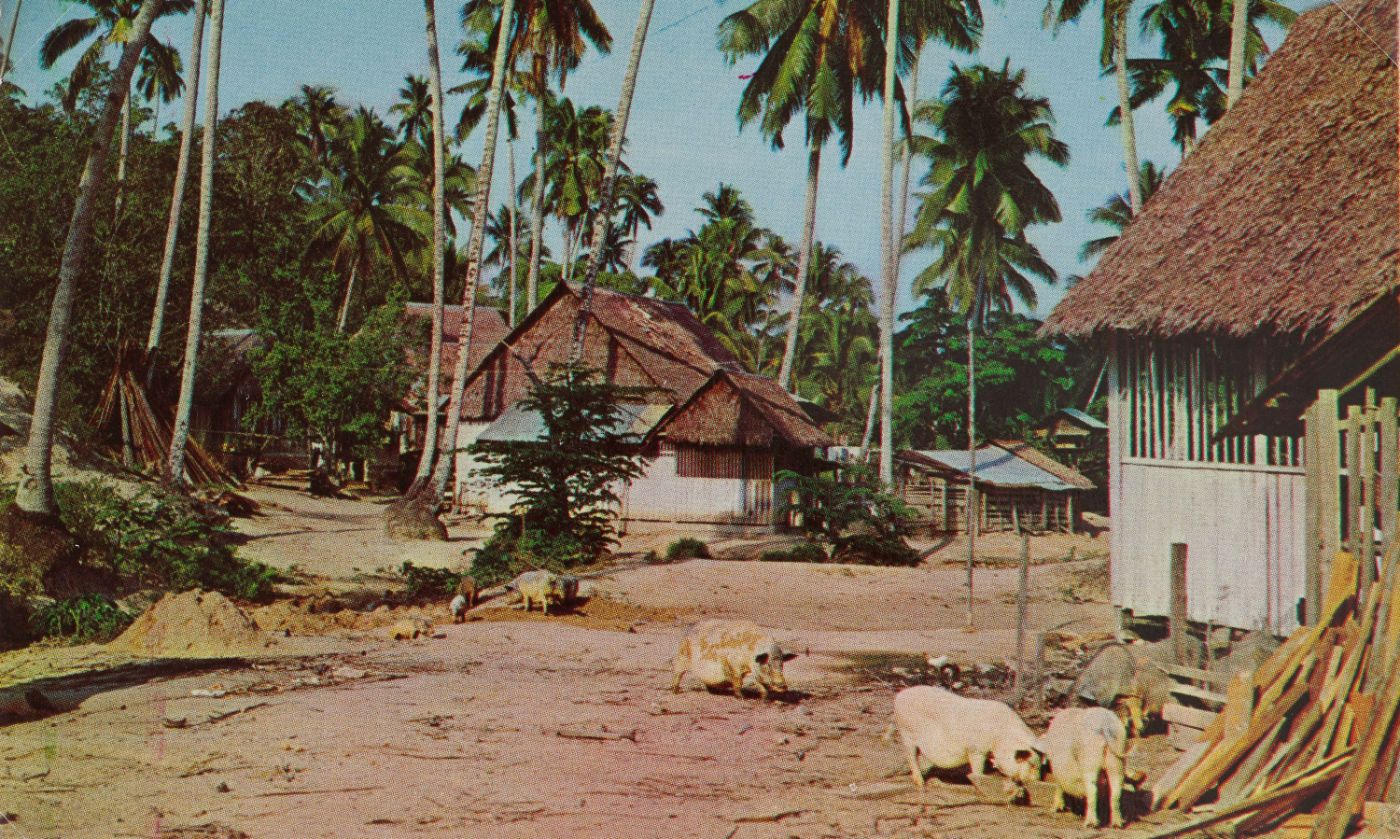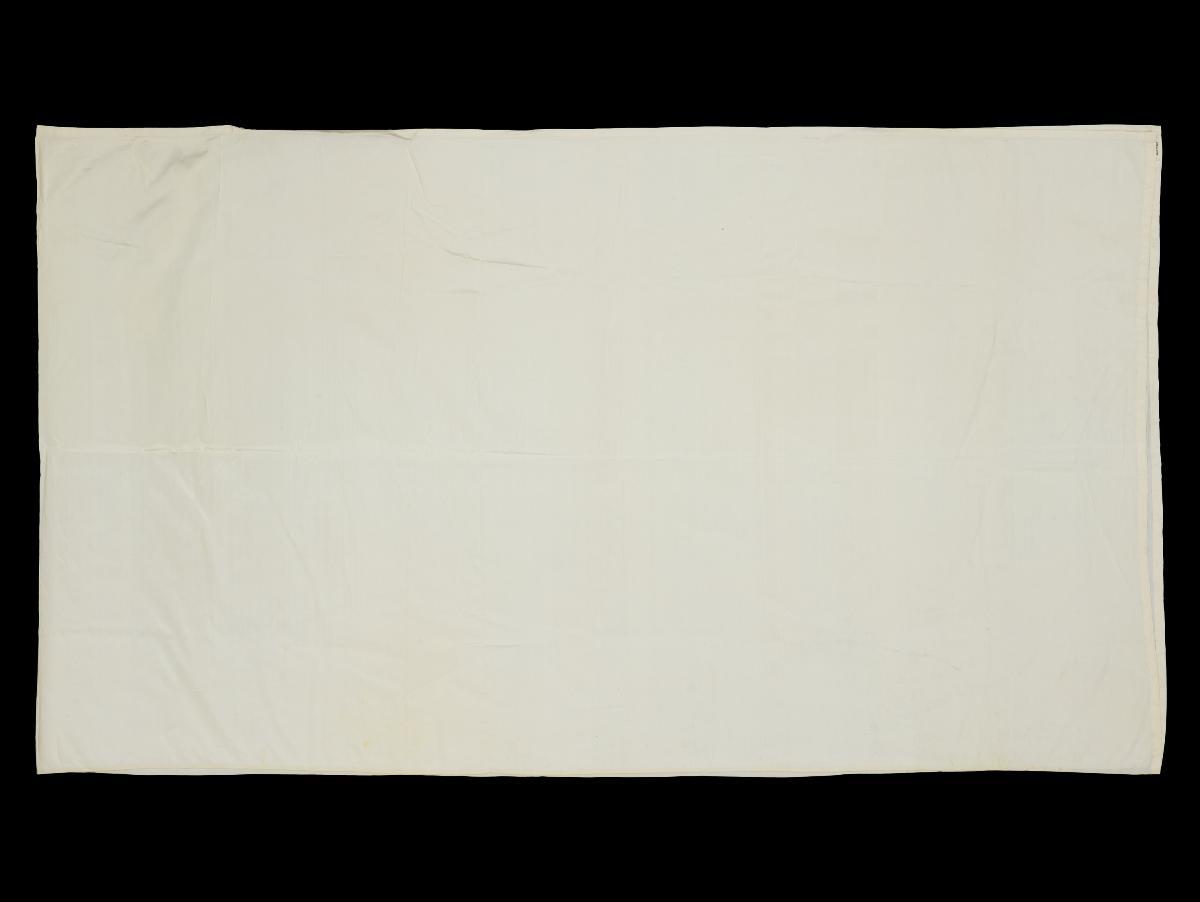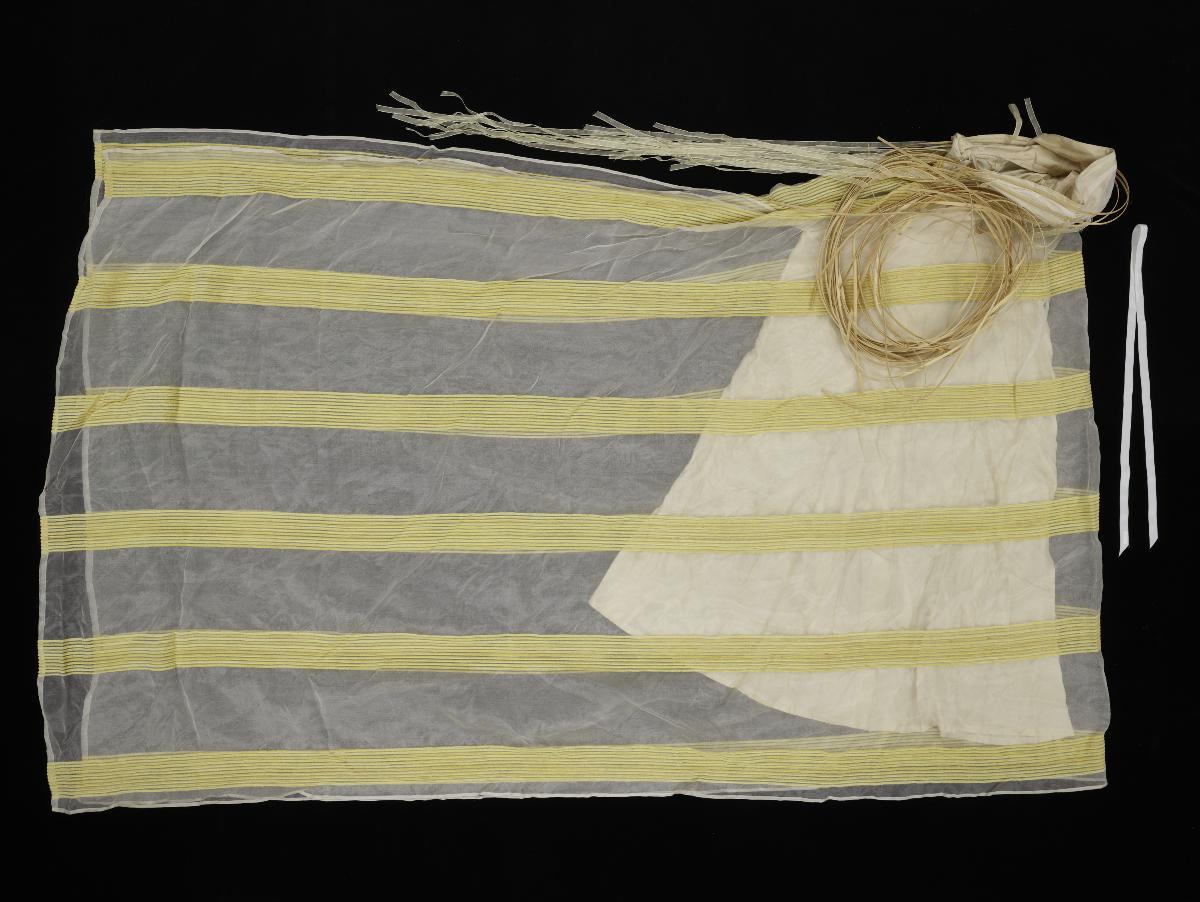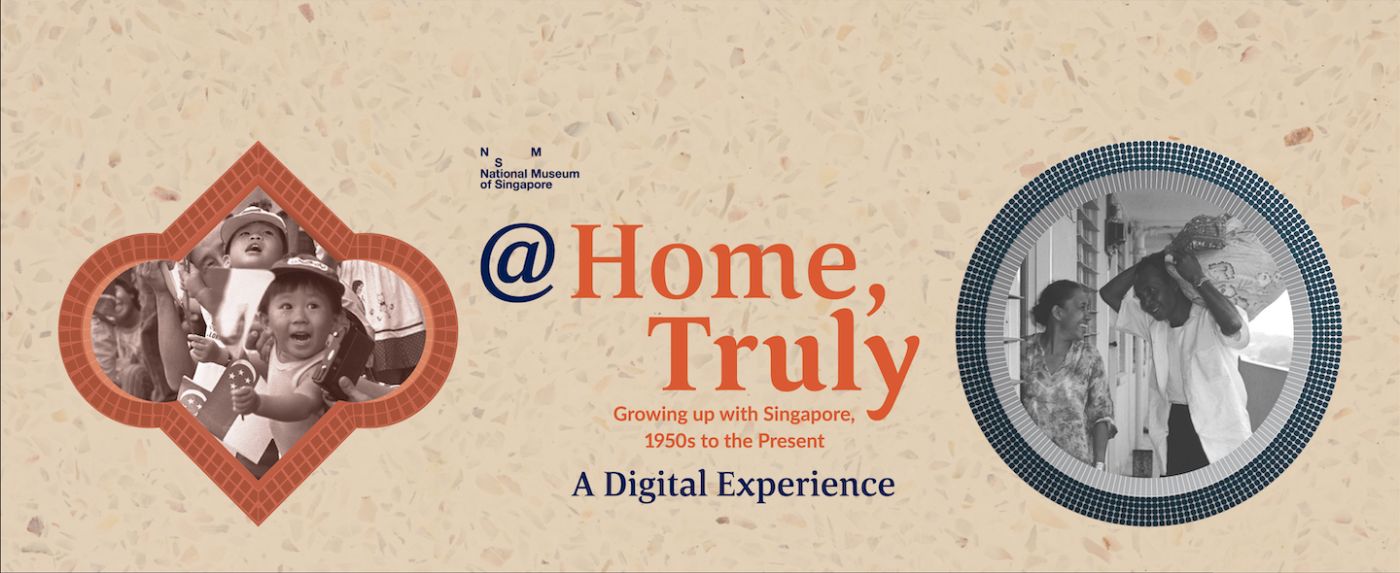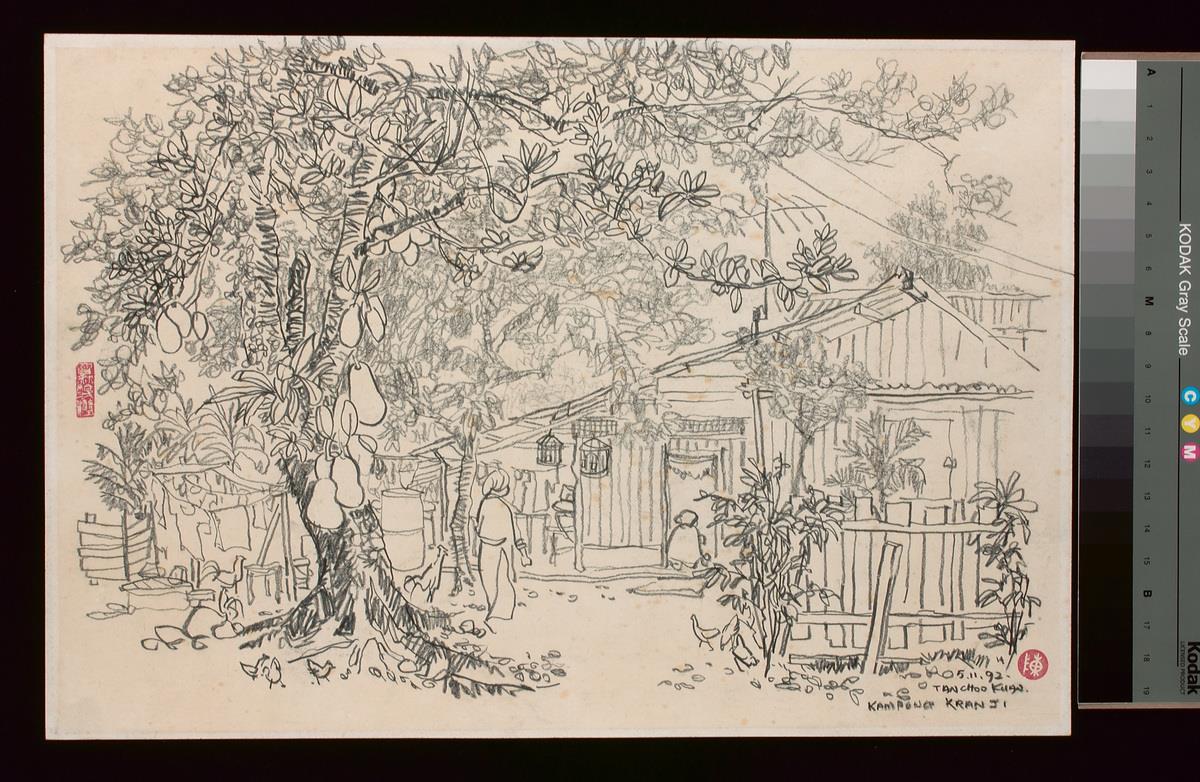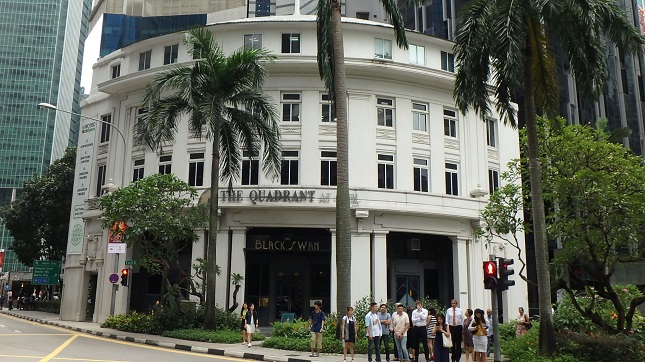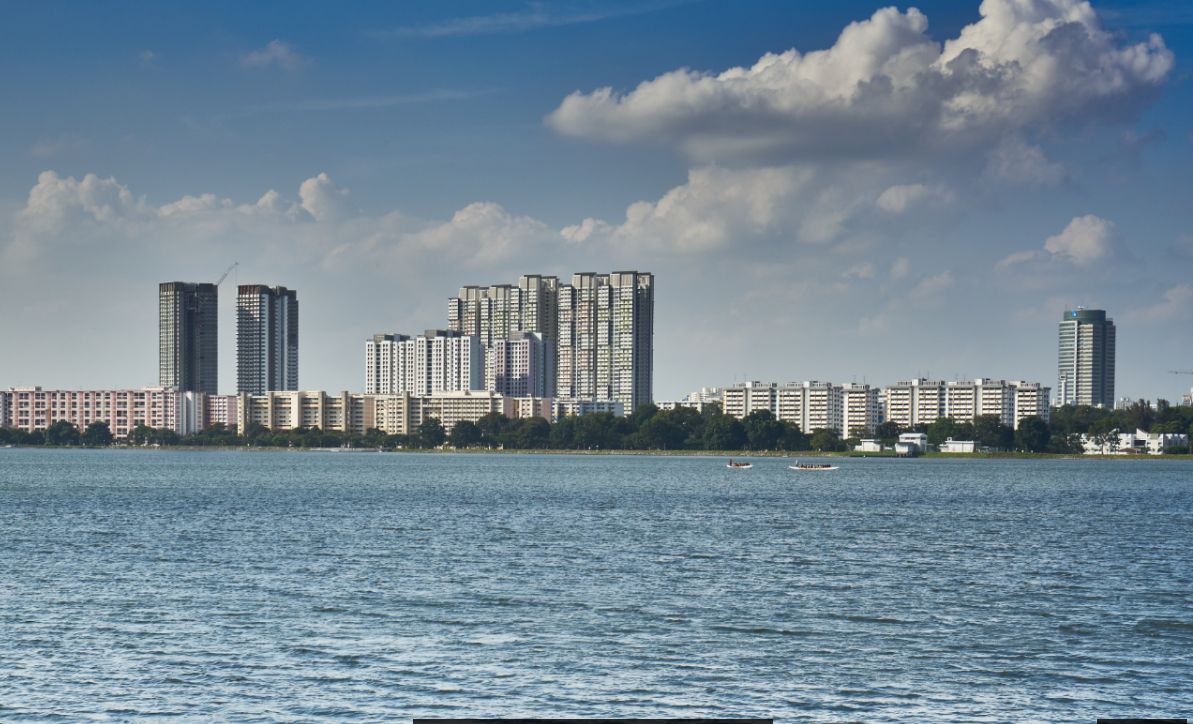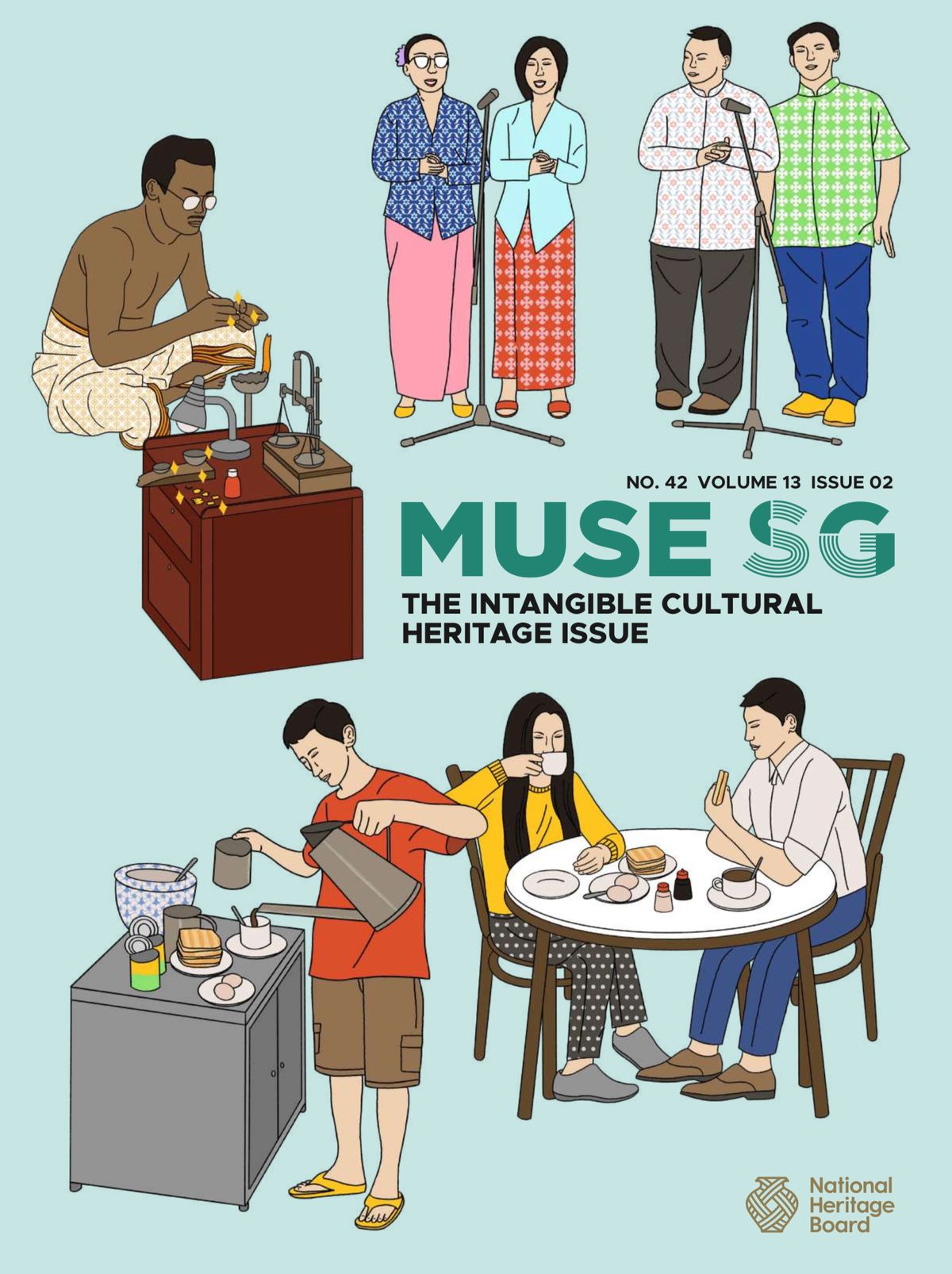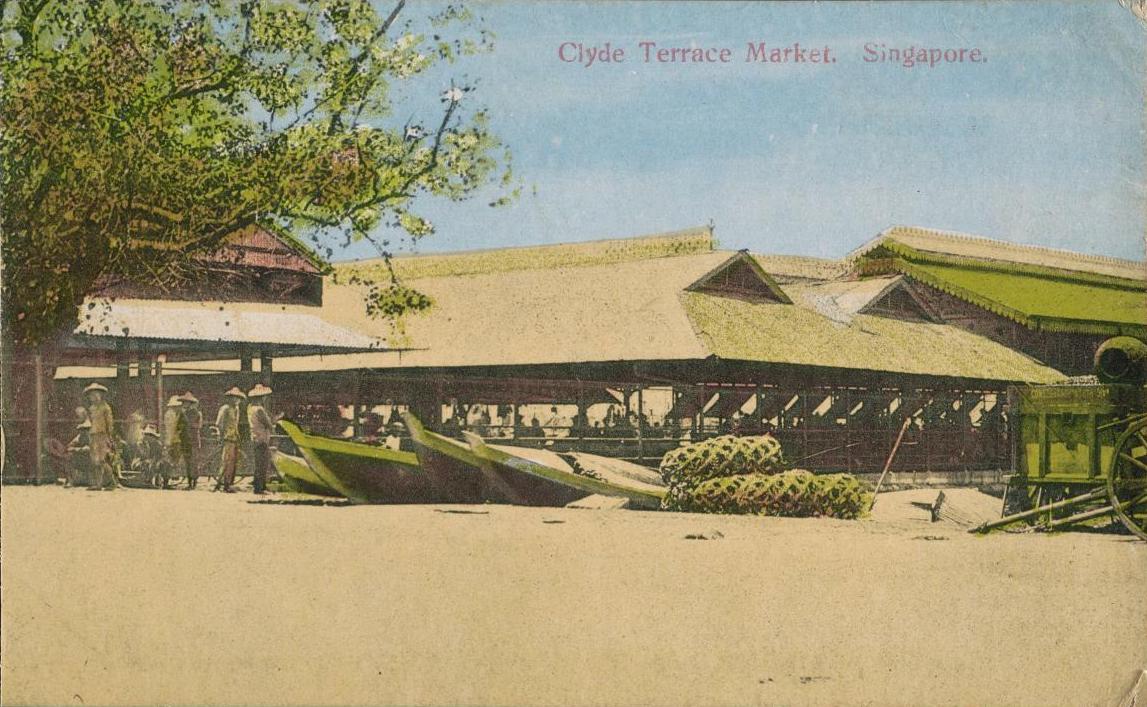+65 Volume 2 – 2022
Text by
Choo Ruizhiof the S. Rajaratnam School of International
Studies (RSIS)
Read the full +65 publication here
In bak chor mee, babi pongteh, and Korean barbecues. In
restaurants, hawker centres, and kopitiams. In 2020 alone,
Singapore consumed 123,625 tonnes of pork, making it the most popular red
meat in the country.1 Yet none of this pork was raised locally,
because there have been no pig farms in Singapore since 1989.2
The pork Singaporeans eat today comes either chilled, frozen, or fresh from
over 20 different countries.3 Today, the only pigs left in
Singapore are wild boars which roam the forested fringes of the island.
Occasionally, these animals drift closer to human habitats, surfacing on
social media and newspaper articles.
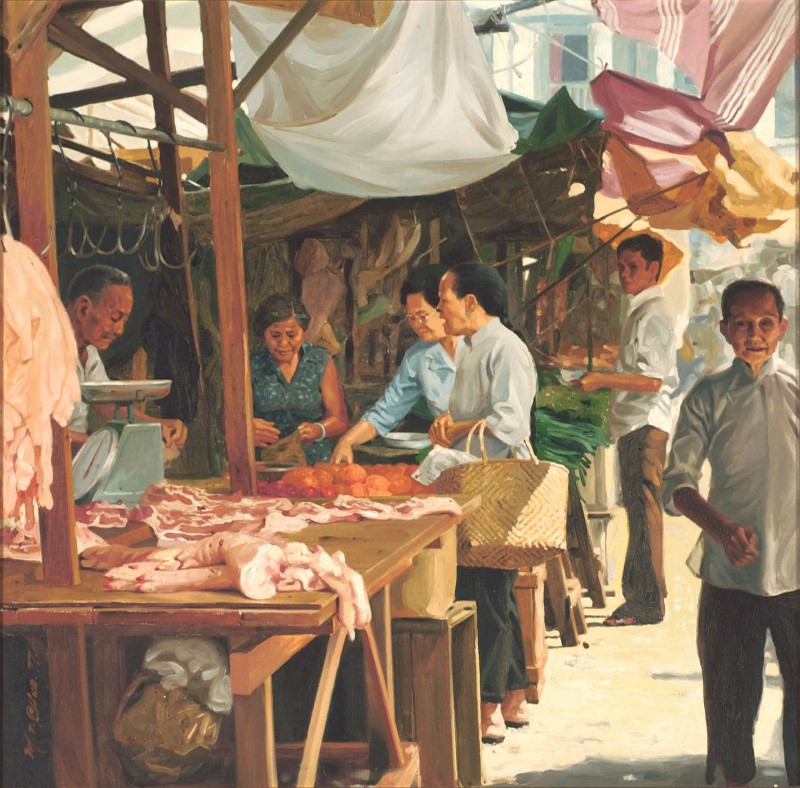
Chua Mia Tee,
Amah Shopping in Chinatown (Pork Stall) 1977. Oil on canvas, 78.5 x 79.4 cm. Gift of Times Publishing Limited.
Collection of National Gallery Singapore.
Today, the only pigs left in Singapore are wild boars which roam the
forested fringes of the island. Occasionally, these animals drift closer to
human habitats, surfacing on social media and newspaper articles.
Yet until as recently as the mid-1980s, over a million pigs were raised
annually in farms across Singapore, producing almost all the pork
Singaporeans consumed.4 Evolving government policies, however,
eventually determined that such self-sufficiency was not sustainable. The
local pork industry, though tremendously efficient, came at the expense of
other aspects of the country’s development, and was thus gradually
phased out.
Over the decades, Singapore’s policymakers have had to balance the
varying, sometimes conflicting demands of multiple stakeholders, so as to
ensure that different aspects of Singapore’s socioeconomic growth
could be managed. The local pork industry was one such area in which
disparate concerns about economic viability and environmental impact
intertwined, resulting in policy changes that markedly transformed how
Singaporeans obtained and consumed this protein. This short essay thus
surveys how changing sustainability considerations since the 1960s affected
pig farming in Singapore, leading ultimately to the imported pork
Singaporeans consume today.
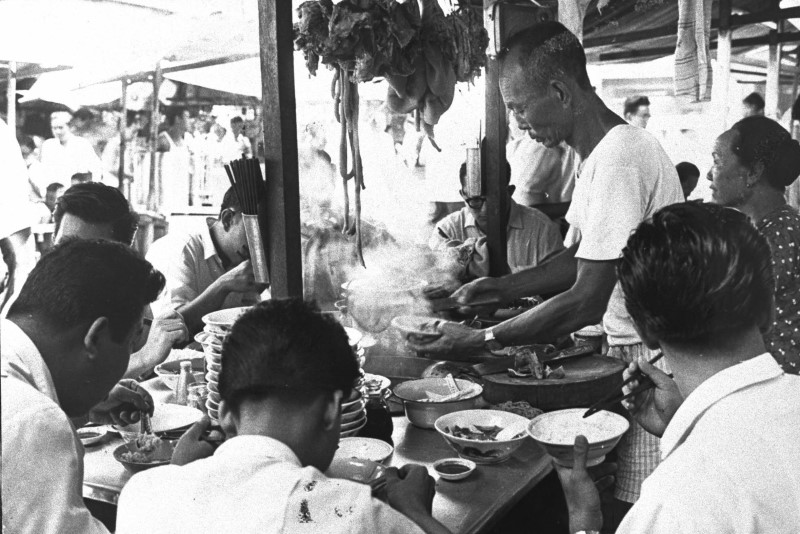 A street side hawker selling pork innards soup, 1965. Ministry of Culture
Collection, courtesy of the National Archives of Singapore.
A street side hawker selling pork innards soup, 1965. Ministry of Culture
Collection, courtesy of the National Archives of Singapore.
The 1960s: Food Self-sufficiency
As compared to the present, Singapore in 1965 resembled a different
country. Sprawling expanses of farmland supported large rural communities,
and pig farms dotted the banks of the Kranji and Kallang rivers.
To help meet Singapore’s growing food needs, the then-Primary
Production Department (PPD) set out to improve the efficiency of existing
farms with better education and equipment.5 Lectures and study
trips were organised, while high-quality pig breeds and feedstock were
provided to farmers.6 In 1965, Singapore’s first farm
school was established in Sembawang.7
Taken together, these efforts saved the country “millions of dollars
in foreign exchange” by minimising the need to purchase imported
pork.8 But changes were on the horizon. Competing national
priorities meant that even efficient, small-scale farming could not be
sustained in the long run.
The 1970s: Competing Priorities
By the early 1970s, dramatic changes were occurring in Singapore’s
society, economy, and environment. In particular, Singapore’s meteoric
economic growth had begun generating tensions and trade-offs. Balanced
against other national priorities, pig farming in Singapore had to be
reorganised. Farmland shrank to make room for new factories, housing
estates, and military training grounds.
“We had about 6000 pigs before moving over here from Ang Mo Kio.
But with various facilities provided to us, we have an additional 4000
pigs now, after only about half a year of resettlement.”
-Tan Hong Chuay, owner of 3.25
–hectare farm with about 10,000 pigs, in a 1977 interview with
New Nation9
Meanwhile, to improve Singapore’s water security, large waterways
like the Kranji River were dammed to create reservoirs. Large farms in water
catchment areas such as Lim Chu Kang, Jurong, and Seletar were relocated to
newly-created farming estates in Tampines, Punggol, and Jalan Kayu to
prevent pig waste from contaminating new freshwater sources. Small-scale pig
farmers were encouraged to raise less pollutive livestock, or to give up
farming entirely.10 The era of intensive farming had
arrived.
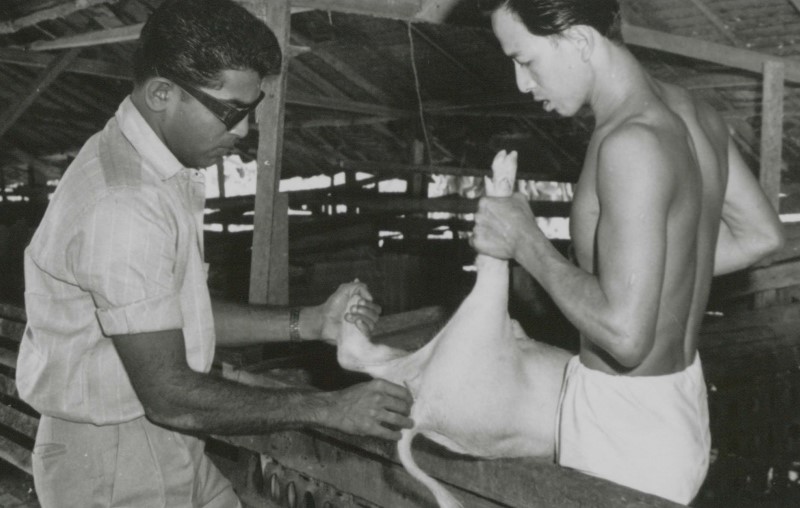
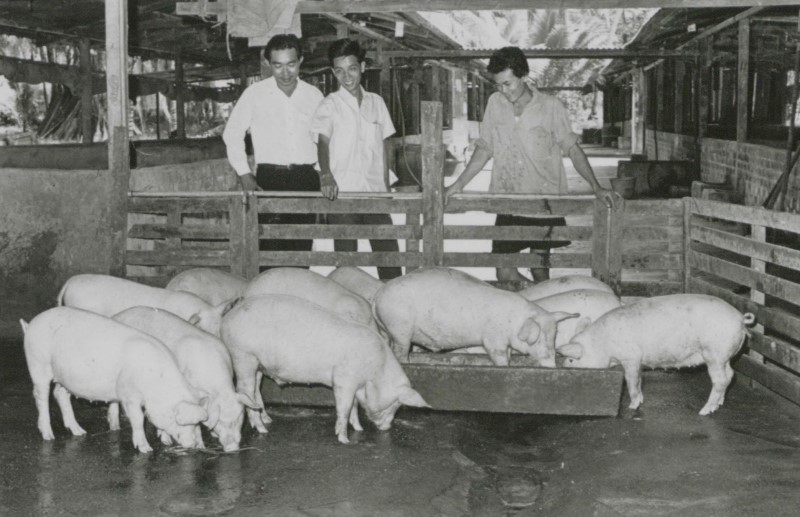
Pig farms, 1960s. Ministry of Information and the Arts Collection,
courtesy of the National Archives of Singapore.
Punggol Pork
One of the government’s most ambitious experiments in intensive
farming during this period was its development of the Punggol pig-farming
district. Over 1,000 hectares of land was allocated to this venture.
Electric cables and water pipes were laid, new roads were built, and
government flats constructed to house resettled farmers.11 The
Punggol Pig Centre, a laboratory specialising in pig diseases and pig farm
management, was also established in Jalan Serangoon Kechil.12
By 1977, the newly resettled pig farms in Punggol had considerably exceeded
production targets despite the decrease in available farmland. The PPD
declared Singapore “self-sufficient in pigs”.13 Intensifying pig farming with modern technologies had allowed for more
efficient, sustainable use of resources. By September 1980, Singaporean
farms were producing over 1.25 million pigs annually.14 Despite
these improved efficiencies, however, changes were soon afoot again. The
1980s would bring new choices and challenges.
“Does it make sense to spend some $80 million on waste treatment
plants to achieve poor environmental standards? If pig farms have
eventually to go, why prolong the agony?”
-Dr Goh Keng Swee, in response to a question filed in Parliament in
198415
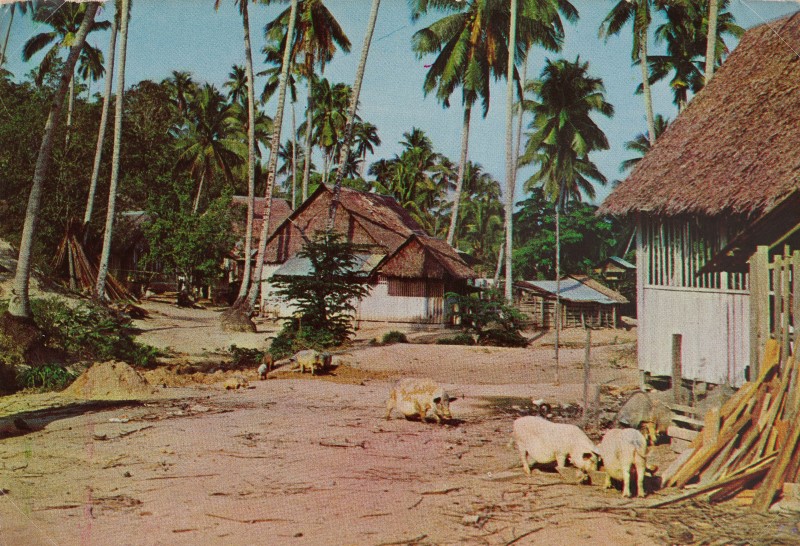
A pig farm at Punggol, 1970s. Collection of the National Museum of
Singapore, National Heritage Board.
The 1980s: The End of Singaporean Pork
Despite the local pork industry’s high production output,
policymakers by the early 1980s determined that pig farming was
unsustainable when balanced against other aspects of national
development.
In March 1984, Dr Goh Keng Swee, First Deputy Prime Minister, announced
that all local pig farms would be progressively phased out. All of
Singapore’s pork would henceforth be imported.16
“When they mentioned that they wanted to phase out the pig farming,
everybody was furious
… it really hit the farmers who are about 40, 50 years old …
when they are at this stage, you know, to tell them to go out and do other
business, it’s not easy.
My farm? We had to accept it, unwillingly, unfortunately. But that was the
government policy, so we had to stop.”
-Hay Soo Kheng, a pig farmer, in a 1991 interview with the National
Archives of Singapore17
After “a major review of pig policy”, the state had concluded
that the extreme toxicity of pig waste, expensive waste treatment plants,
and the resource-intensive nature of pig farming in general made it
economically and environmentally unsustainable in the long run. It would be
efficient, the government argued, to “supply the whole of our pork
requirements through imports, probably at a lower cost”.18
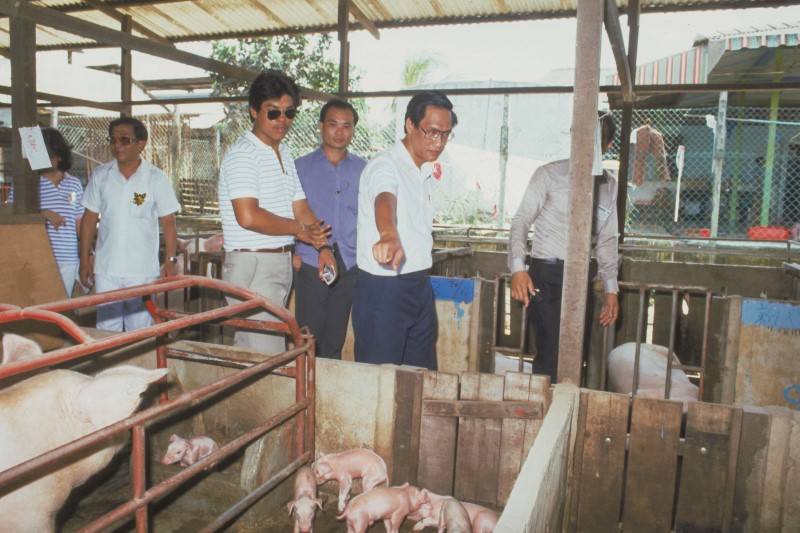
Minister without Portfolio Lim Chee Onn visiting a pig farm at Buangkok
South Farmway, 1983. Ministry of Information and the Arts Collection,
courtesy of the National Archives of Singapore.
The decision had been made at the highest levels of government, who brooked
no protest to this difficult decision.19 Despite widespread
disappointment from farmers and even some PPD officers, the reaction to this
decision amongst most Singaporeans appeared to have been relatively
muted.
The ambivalent response might have been a product of broader shifts in
Singapore’s economy. Many small farmers had already been transiting
out of the pork industry for years, farming other crops, or exploring other
livelihoods due to diminishing state support for pig farming.
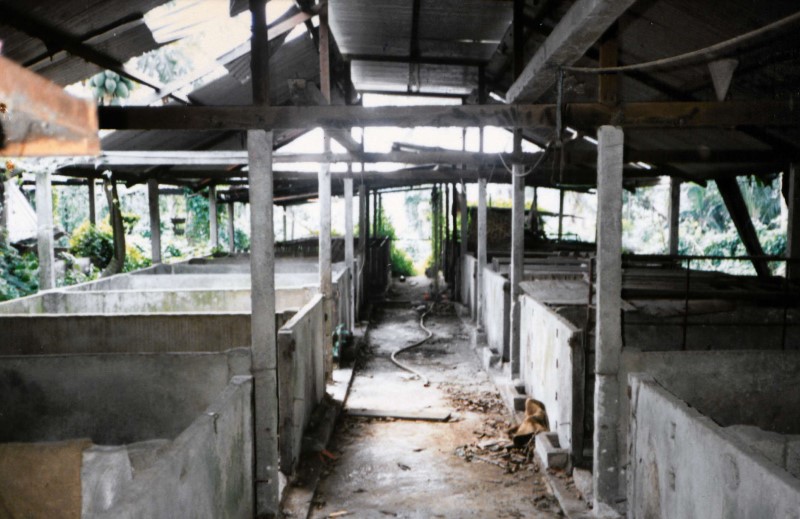
Rows of empty concrete pig enclosures at Lim Chu Kang Road, 1987. Housing
and Development Board Collection, courtesy of the National Archives of
Singapore.
For instance, stuck with excess pigs in his farms, Mr Lim Hock Chee turned
to selling chilled pork from a rented booth in a Savewell Supermarket outlet
at Ang Mo Kio in 1984, and was later able to take over the management of the
entire store. The decision marked the beginning of the Sheng Siong
supermarkets, which has today grown to an island wide chain of 61
outlets.20
“Now I’m 55. I have been farming since I was 18. What other
work can I do … The happiest thing in my life is that I have raised
eight children and I don’t owe anybody any money … That’s
not bad, isn’t it, considering I never learnt to read and
write?”
-Poh Ah Leck, owner of a small family-run pig farm, in a 1985 interview
with The Straits Times21
After phasing out pig farms, the Government was not idle either. In
addition to the monumental task of closing down local farms, PPD officials
fanned out throughout the region, seeking suppliers in Indonesia, Malaysia,
and Australia. New infrastructures were built to transport and market fresh,
chilled, and frozen pork locally. Publicity campaigns encouraged
Singaporeans to consume more imported pork.
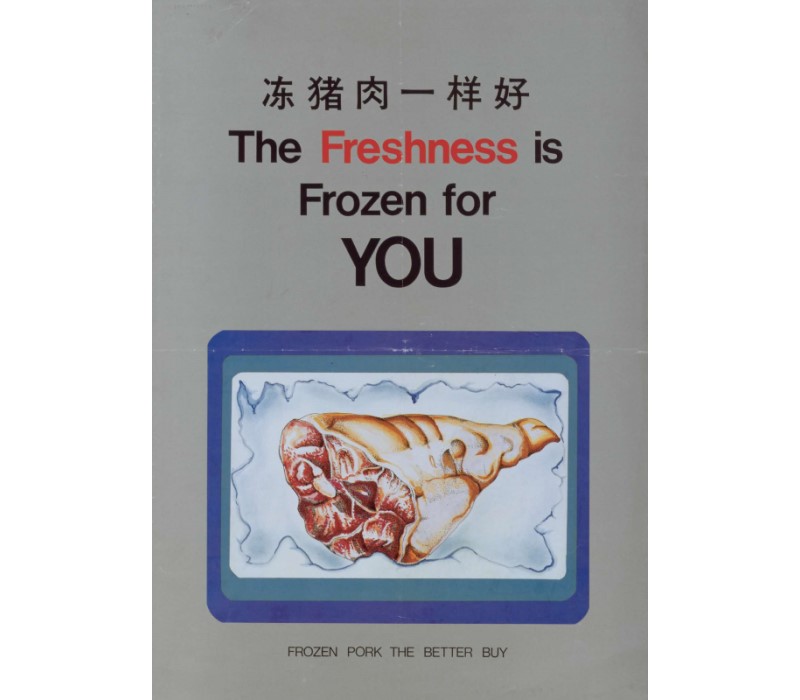
Poster from the “Eat Frozen Pork Campaign”, 1985. Primary
Production Department Collection, courtesy of the National Archives of
Singapore.
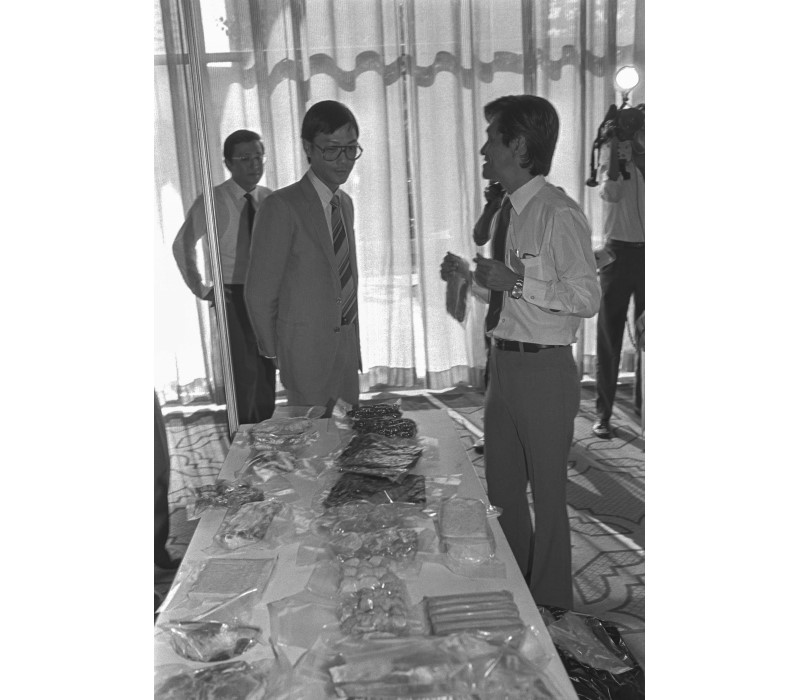
Member of Parliament for Jalan Besar, Dr Lee Boon Yang, at the “Eat
Frozen Pork Campaign” exhibition, 1985. Ministry of Information and
the Arts Collection, courtesy of the National Archives of Singapore.
“Mr Lim Chye Joo, 82, said Primary Production Department (PPD)
workers came to his farm on Tuesday and put away two of his male pigs with
a lethal injection […] Mr Lim has 18 females and 12 piglets left.
He said PPD men will return on Monday to kill the rest.
‘It is not economical to sell them off because transportation costs
for such a small lot exceed any profits to be made,’ he said.
‘The female pigs are already old. There is no point trying to sell
the piglets off because farms in Punggol, Tampines, Changi and Sembawang are
being closed at the same time and the market will be flooded,’ he
added.”
An excerpt from “No market for these swine”, The New Paper,
26 Nov 198822
The era of Singaporean pork was over. Henceforth, Singaporeans (with
initial reluctance) would begin consuming pork, grown in overseas farms, in
increasing quantities.
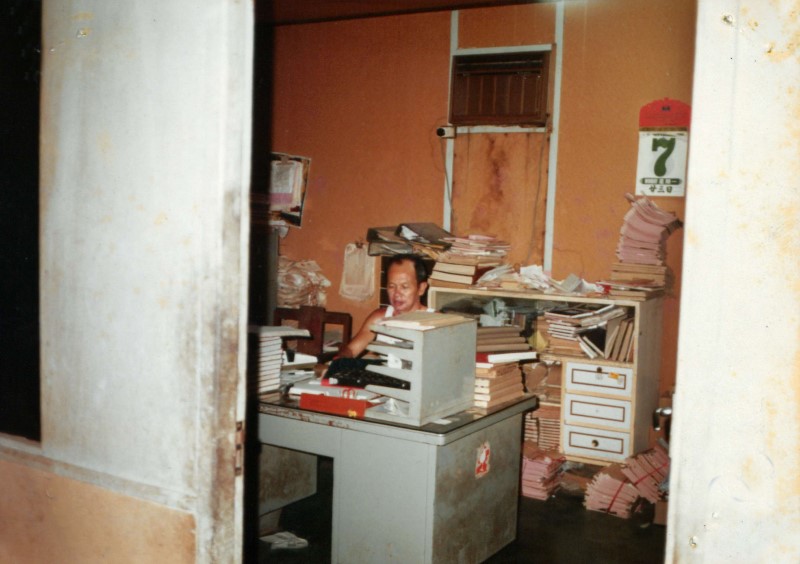
A pig farm owner in his office at Lim Chu Kang Road, 1985. Housing and
Development Board Collection, courtesy of the National Archives of
Singapore.
Singapore, Swine, and Sustainability
The story of Singaporean pork illustrates how stark choices had to be made
in Singapore’s early nation-building years, as leaders and citizens
alike strove to balance economic imperatives with growing concerns about
environmental sustainability. Entwined with these grand narratives of
national progress are hence also smaller stories of sacrifice, uncertainty,
and loss.
Yet policymakers and pig farmers alike met these challenges with tireless
determination and bold ingenuity, reinventing themselves to meet evolving
contexts. History cannot predict the future, but perhaps this brief story of
swine and sustainability shows us how we can likewise rise to meet the road
ahead: with grit, daring, and imagination.
Choo Ruizhi is a Senior Analyst in the National Security Studies Programme (NSSP) at the S. Rajaratnam School of International Studies (RSIS). He is interested in the histories of animals in colonial and early post-independence Singapore. In his free time, he likes to wander through Singapore’s past and present landscapes on foot, by bus, and in the archives.




